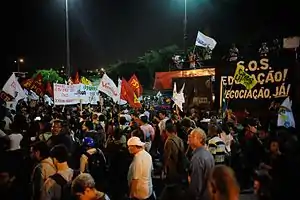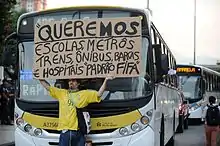| 2014 Brazil FIFA World Cup protests | |||
|---|---|---|---|
 Protesters against the World Cup march in the center of Rio de Janeiro. | |||
| Date | June 2013 - July 2014[1] | ||
| Location | |||
| Caused by | Perceived injustices around 2014 FIFA World Cup expenditures, forced removals of poor habitations, low spending on public services | ||
| Goals | • Worker reivindications, • Better housing, • End of the forced removals, • Free and good-quality Public services, • End of the UPP, • End of urban militarization, • End to Police brutality | ||
| Methods | • Strikes, • Barricades, • Demonstrations, • Occupations, • Autodefense of masses, • protest marches, • online activism, • direct action | ||
| Status | Major protests subsided | ||
| Number | |||
| |||
| Casualties | |||
| Injuries | 42 | ||
| Arrested | 234 on 16 May[1] | ||
The 2014 protests in Brazil, also known as There won't be a Cup[3][4] or Fifa go home[5] were public demonstrations in several Brazilian cities in response to the 2014 FIFA World Cup and other social issues, realized by many social movements, mostly in the capitals where the megaevent was happening, Their main criticism was the high government spending on the World Cup to the detriment of low investment in public services. Furthermore, they criticized forced evictions and lack of policies in favor of decent housing, urban militarization and police violence. Several categories of workers also added demands in favor of better conditions for work.[2][6][5][7][8][9]
Background
The protests were primarily concerned with the spending of billions of reais of public money on stadiums for the World Cup.[1]
Prior to 2014, social movements opposed to Brazil hosting the Cup garnered support during the FIFA Confederations Cup in 2013. The Facebook group Movimento Anti-Copa de Decoração de Ruas (Anti-Cup Movement for the Decoration of the Streets) gained more than 15,000 Likes in a little over a month.[10]
Timeline
Events prior to the World Cup
On January 25, 2014, protesters clashed with the military police in central São Paulo. According to the organization's official Facebook account, 108 people were arrested by military police and a further 20 arrests were made by civil police, totaling 128 arrests before midnight.[11]
On May 27, 2 protesters blocked the streets in central Brasília, near the Monumental Axis, caused traffic congestion. Among the protesters were 300 aboriginals who went to the capital to protest changes in laws concerning the demarcation of indigenous land. The protest ended in a confrontation with the military police, where a cavalryman was struck by an arrow.[12]
On May 31, 2014 protesters marched from the Ministries Esplanade to the football stadium before ending the demonstration peacefully.[13] The following day, military police in São Paulo began using specialized suits of armor referred to as 'RoboCop', which were intended to maintain control over protests during the World Cup.[14]
On June 3, a group of about 50 protesters in Goiânia gathered in front of the hotel where the Brazilian team was staying prior to an exhibition match against Panamá. The protesters were connected with trade unions and left wing political groups, with pickets demanding fair pay for professors and health professionals.[15]
Events during the World Cup
The demonstrations of 2014 were generally smaller than those that occurred during the FIFA Confederations Cup in the previous year, but protesters and police clashed in almost every city hosting the games of the World Cup. In the first week of the Cup, there were more than 20 protests and 180 arrests across the various cities, many resulting in police action.[16]
On June 12, at least six were injured in São Paulo when military police threw gas grenades and fired rubber bullets at protesters. Two CNN journalists were among those injured.[17] Governor Geraldo Alckmin of the Brazilian Social Democracy Party justified the aggression of the military police saying that their goal was to prevent the protesters from blocking a major traffic artery leading to the football stadium.[18]
In Porto Alegre on June 24, around 200 protesters gathered in the city center and travelled toward the airport. The group was monitored by police, and disbursed with one protester being arrested for deflating the tires of a car.[19]

In São Paulo, June 23, an unidentified man in a black shirt fired a gun three times into the air as police were arresting a protester. Protesters say that the man was trying to scare away those critical of the arrest. Police said they would investigate whether the shooter was actually a member of the police. Three people were arrested during the act, among which Rafael Lusvarghi.[20]
On July 13, the final day of the Cup, police in Rio de Janeiro injured at least ten journalists with clubs, and shrapnel from tear gas grenades. Police kettled the 300 protesters, preventing them from marching to their destination, Maracanã Stadium. Military Police told BBC Brazil that they would forward reports of police abuse to Internal Affairs.[21]
Events
Reasons of the protest continuation are pointed also by Romário, ex-player and member of the Parliament, that dubbed the World Cup 2014 as the "biggest theft in history", and that the real costs would be over R$100 billion (US$46 billion). Romário now is one of the few parliament members that wants a deeper investigation on the misuse of public funds.[22][23][24][25][26]
Before the opening game of the World Cup on 12 June, police clashed with protesters in São Paulo, Rio de Janeiro and several other host cities. Tear gas was used on crowds in São Paulo.[27][28]
While covering the protest on June 12, CNN Reporter Shasta Darlington and CNN producer Barbara Arvanitidis were injured. Barbara Arvanitidis was directly hit on the wrist by a tear gas bomb whilst they were reporting the indiscriminate use of riot weapons.[29][30][31]
See also
References
- 1 2 3 "Brazilian anti-World Cup protests hit Sao Paulo and Rio". BBC News. 16 May 2014.
- 1 2 Brazil police, protesters clash as World Cup begins
- ↑ Paula Bianchi (2 June 2014). "Valcke ironiza "não vai ter Copa": já está tendo". Portal Terra. Archived from the original on 6 June 2014. Retrieved 3 June 2014.
- ↑ Ciro Barros (20 February 2014). "Conheça os ativistas que gritam "não vai ter Copa"". UOL. Retrieved 2 June 2014.
- 1 2 SILVA, Geraldo (2013).‘Call me the World Cup and invest in me’†. A commentary on Brazil’s recent street protests against the World Cup and the Olympic Games. Taylor and Francis.
- ↑ Brazil braces for uneasy start to World Cup as strikers' protests hit São Paulo
- ↑ FIP (2014). Por que gritamos "Não Vai ter Copa"?.
- ↑ SILVA, Selmo Nascimento de (2018). O ciclo de greves contemporâneas no Brasil: o levante proletário de 2013 e a experiência da greve negra dos garis do Rio de Janeiro de 2014 numa perspectiva anarquista. Revista Eletrônica Espaço Acadêmico, v.18, p.89-101.
- ↑ Jennings, Andrew (org). Brasil em Jogo: o que Fica da Copa e das Olimpíadas?. Editora Boitempo. São Paulo.
- ↑ "Movimento reúne pichações e arte contra a Copa do Mundo no Brasil".
- ↑ "Grupos protestam pelo Brasil contra a realização da Copa do Mundo".
- ↑ "Protesto contra a Copa termina em confronto com a polícia no DF". 27 May 2014.
- ↑ "Protesto contra a Copa do Mundo reúne 200 manifestantes em Brasília". 30 May 2014.
- ↑ "Protesto contra a Copa reúne 500 pessoas no Centro de São Paulo". 31 May 2014.
- ↑ "Protesto contra Copa leva confusão à rua de hotel do Brasil". 3 June 2014. Archived from the original on 12 August 2014.
- ↑ "Com mais de 20 protestos, 1ª semana de Copa tem 180 detidos em atos". 19 July 2014.
- ↑ "Protestos atraem menos gente, mas voltam a registrar violência". 13 June 2014. Archived from the original on 15 July 2015. Retrieved 7 August 2014.
- ↑ "Bombas de gás e spray nos olhos: é assim que a polícia reage aos protestos". 13 June 2014.
- ↑ "Protesto contra a Copa reúne mais policiais do que manifestantes". 23 June 2014.
- ↑ "Protesto contra Copa termina com detidos na Avenida Paulista". 23 June 2014.
- ↑ "Polícia usa violência em protesto e fere ao menos 10 jornalistas no Rio". 13 July 2014. Archived from the original on 27 July 2014. Retrieved 18 August 2014.
- ↑ "Romário diz que Copa de 2014 será o 'maior roubo da história'". 13 June 2014.
- ↑ "Copa será o maior roubo da história". 13 June 2014. Archived from the original on 14 July 2014. Retrieved 13 June 2014.
- ↑ ""Copa do Mundo vai custar R$ 100 bilhões para o Brasil", diz Romário". 13 June 2014. Archived from the original on 2014-07-14. Retrieved 2014-06-13.
- ↑ "Romário diz ao R7 que Brasil vai gastar R$ 100 bilhões na Copa". 13 June 2014. Archived from the original on 2014-10-20. Retrieved 2014-06-13.
- ↑ "Romário volta a criticar organização da Copa: "o Brasil perdeu de goleada"". 13 June 2014.
- ↑ "Brazil World Cup: Clashes at Sao Paulo and Rio protests". BBC News. 12 June 2014. Retrieved 13 June 2014.
- ↑ "Anti-World Cup protests in Brazilian cities mark countdown to kick-off". Guardian. 12 June 2014. Retrieved 13 June 2014.
- ↑ "CNN producer left bloodied after trouble breaks out on day one in Brazil". 12 June 2014. Archived from the original on 14 July 2014.
- ↑ "Brazilian police fire tear gas at World Cup protesters; CNN employees injured by anti-riot weapons". 12 June 2014.
- ↑ "Sao Paulo violent protests on World Cup opening day as journalist 'injured' amid rubber bullets and stun grenades". 12 June 2014.
External links
 Media related to Demonstrations and protests in Brazil in 2014 at Wikimedia Commons
Media related to Demonstrations and protests in Brazil in 2014 at Wikimedia Commons
